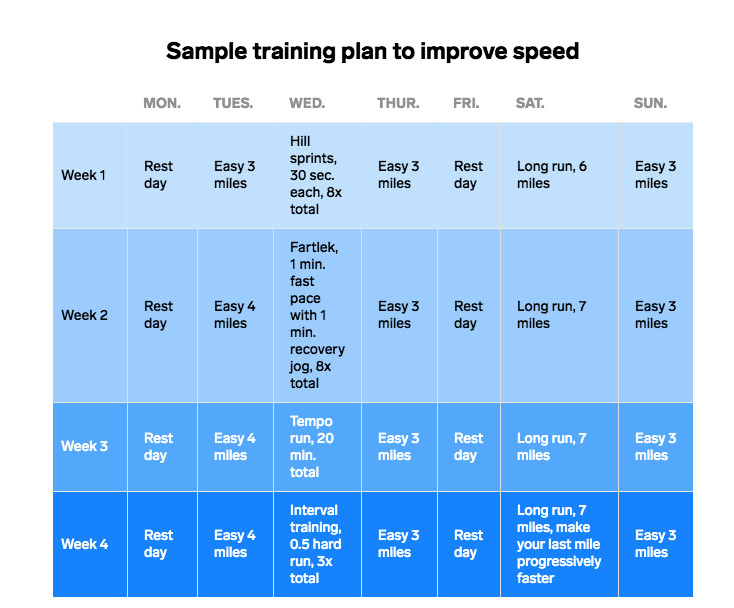Running News Daily
Running News Daily is edited by Bob Anderson. Send your news items to bob@mybestruns.com Advertising opportunities available. Train the Kenyan Way at KATA Kenya and Portugal owned and operated by Bob Anderson. Be sure to catch our movie A Long Run the movie KATA Running Camps and KATA Potato Farms - 31 now open in Kenya! https://kata.ke/
Index to Daily Posts · Sign Up For Updates · Run The World Feed
7 ways to run faster, according to expert running coaches
Achieving a faster pace can be a thrill for runners, and it also happens to be great for your overall health.
"We get stronger, faster, fitter, and leaner when we introduce a new stress, like speed training workouts, to our body," says Elizabeth Corkum, a Road Runners Club of America certified running coach.
Whether you're looking to increase your pace for race day or just seeking an extra boost for your workouts, here are seven tips on how to bump up your speed.
1. Add tempo runs
Tempo runs are 10 to 45 minute runs at a steady pace, according to Corkum. These workouts can help runners develop discipline by controlling their speed and help their bodies learn how to handle stress.
These should be done at a controlled pace, meaning you should be able to maintain the same pace throughout your run. The first few minutes of the run should feel easy and you might even feel like you are holding back a bit.
However, by the middle to end of the run you should start to feel uncomfortable. "At the end of your tempo run is when it will really start to feel like a speed workout," says Corkum.
Tempo runs build strength and speed because they push you to reach your anaerobic threshold. Your anaerobic threshold is the point where your body produces lactic acid — a byproduct of working out. When lactic acid builds up in your muscles, it makes your legs feel heavy and the run becomes more difficult.

So, the sooner you reach your anaerobic threshold, the sooner you'll burn out, and the harder it will be to finish — let alone run faster. That's where tempo runs come in, because they train you to run longer and faster before hitting that threshold.
"Increasing this threshold by training smart allows you to run faster for longer periods of time before that feeling of fatigue or lactic acid takes over,"says Audrey Springer, a Road Runners Club of America certified running coach. "An athlete could do this as a workout for a duration of 15 minutes and build all the way up to an hour or more depending on the race they are training for."
Compared to sprints and hill runs, tempo runs are lower intensity, longer workouts. The pace for tempo runs will be faster than an easy run or jog, but still slower than a sprint like a 5k or 10k pace. One tool that Springer uses is Jack Daniels' VDOT Running Calculator to help her runners set a tempo run pace.
Springer says there are three different types of tempo runs.
Lactate threshold: This is where the athlete will run at a pace they could ideally hold for one hour. If the run is 30 minutes they should feel as if they are pushing hard but they could hold it for another 30 minutes if they were racing.
Marathon/half marathon pace: This type of tempo run should be run at the pace you plan to achieve on race day. This will be slower than the lactate threshold pace.
Progressive: This is also often referred to as negative split run. During this run you will gradually increase speed so your last mile will be fastest. These types of runs are great for establishing a pace, building stamina, and developing mental toughness to help you finish your runs strong.
2. Start weight training
Weight lifting, or strength training, can help you run faster, improve your form, and avoid injuries.
Body weight and plyometric movements that are explosive, such as jumping squats or lunges, can be great for working on speed and power in sprints. "The explosive nature of these movements teaches muscles to contract at a faster and more efficient rate," says Corkum.
Meanwhile, lifting heavy weights with barbells, dumbbells, or kettlebells, can help distance runners maintain power, good form, and efficiency during longer runs such as a 10k or half marathon. However, if you are just starting to weight train, Springer recommends using just body weight at first — like with resistance bands or push-ups — in order to perfect form and avoid injury.
Many weight training movements can also build core muscles. "The core keeps your trunk stabilized, improves your posture and running form, and allows you to generate more power running faster while using less energy," says Springer.
A 2017 review published in the journal Sports Medicine found that adding strength training to a running routine 2 to 3 times a week had a strong, positive effect on running performance. Strength training improved performance in time trials by 3% to 5% in those logging around one to two miles and 2% to 4% in those running around three to six miles.
Runners should spend equal amounts of time building upper body and lower body strength. "It is just as important because the upper body counters the lower body in the running motion," says Corkum.
For building speed, Corkum recommends weight training two to three times a week on non-consecutive days. If you weight train after a run, she suggests waiting at least four to six hours to prevent soreness.
3. Introduce interval training
Interval training is a type of running workout where you alternate between short, intense bursts of running and a brief recovery. The goal of interval training is to maintain the same speed on your first interval as your last one. A 2016 medical review published in The Journal of Physiology found that running sprint intervals builds muscle as well as aerobic endurance.
Another 2018 study published in the Journal of Strength and Conditioning Research assessed 16 trail runners that added interval training to their routine. Each runner completed six interval training sessions over the course of two weeks with two days of recovery between each session. After the training program, the runners were able to run an average of 3.6 more meters in 30 seconds. The study also found that participants increased their speed by an average of 6% in a 3000 meter run.
"Once you begin to incorporate interval training into your workout plan, you will notice your longer runs will become easier and faster," says Corkum.
When you first start interval training, Springer suggests sticking to once a week. The bursts in interval training can be measured by time or distance. Here are two types of interval training workouts that Corkum recommends for running on a track:
Sprint the 100m straightaways on a track and walk or lightly jog the 100m curves. Repeat this four times around the track, so you end up with eight total sprints.
Run for two minutes at 85% effort then take a one minute recovery. Repeat this four times.
4. Practice fartleks
Fartlek is a Swedish word meaning "speed play." A fartlek run consists of alternating between speed and recovery runs. They can last 20 minutes or longer depending on the runner.
Coupling periods of moderate to high intensity running with a slower pace will put stress on both your aerobic and anaerobic treshhold. This will help you build both speed and endurance.
While fartleks are similar to interval training, they are done at an easier effort and slower pace over a longer period of time.
If you are a competitive runner, you can tap into this speed play during a race to help you pass another runner. "Fartleks are all about pushing your pace and effort and figuring out what your limits are," says Corkum.
5. Run hills
Both coaches agree that running hills is a great way to introduce speed training into your running routine. "It is a great stepping stone from aerobic running to sprint repeats on a track," says Corkum. Uphill training will help you become a faster runner and also increase your VO2 max, making you a more efficient runner. VO2 max is a measure of how much oxygen a person can utilize during intense exercise. "The better your body can be at utilizing oxygen, the more energy you'll be able to output or the faster and longer you'll be able to run, " says Springer.
6. Don't forget to take breaks
Oftentimes, runners will skip recovery days out of fear they're losing progress if not constantly running. "What you actually end up doing when you skip recovery days is slowly digging your own grave in terms of progress," says Corkum.
If you moderately work out everyday and don't find yourself improving, Corkum says it's probably because you aren't resting: "A golden rule in running is to make the hard days hard and the easy days easy."
The reason you're sore the day after a workout is because training causes microtears in your muscles. When you rest, those muscle fibers rebuild, slightly stronger than before. Without recovery days, your body is unable to rebuild itself.
According to Corkum, here are some signs you may be pushing too hard and skimping on recovery:
7. Stay consistent
It's important to have a strong aerobic foundation before you begin incorporating speed training into your workout routine. Corkum recommends that new runners or runners that have taken extended time off spend at least four weeks building up their endurance before beginning speed workouts.
"Those easy runs where you can always run further and faster are really important for establishing a strong foundation for running," says Corkum.
Building this endurance will also help you establish a routine to become a more consistent runner, which is important for building speed. "Remember that you get better at what you do often, not occasionally," says Springer, "while rest days are very important so is building a routine and staying consistent."
Login to leave a comment




